Related Research Articles
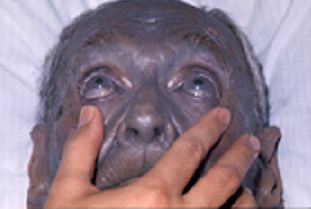
Argyria or argyrosis is a condition caused by excessive exposure to chemical compounds of the element silver, or to silver dust. The most dramatic symptom of argyria is that the skin turns blue or blue-grey. It may take the form of generalized argyria or local argyria. Generalized argyria affects large areas over much of the visible surface of the body. Local argyria shows in limited regions of the body, such as patches of skin, parts of the mucous membrane or the conjunctiva.

Psoriasis is a long-lasting, noncontagious autoimmune disease characterized by raised areas of abnormal skin. These areas are red, or purple on some people with darker skin, dry, itchy, and scaly. Psoriasis varies in severity from small, localized patches to complete body coverage. Injury to the skin can trigger psoriatic skin changes at that spot, which is known as the Koebner phenomenon.

The medical uses of silver include its use in wound dressings, creams, and as an antibiotic coating on medical devices. Wound dressings containing silver sulfadiazine or silver nanomaterials may be used to treat external infections. The limited evidence available shows that silver coatings on endotracheal breathing tubes may reduce the incidence of ventilator-associated pneumonia. There is tentative evidence that using silver-alloy indwelling catheters for short-term catheterizing will reduce the risk of catheter-acquired urinary tract infections.
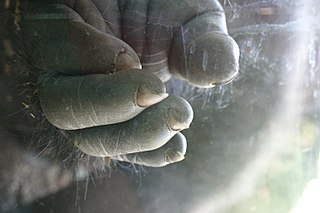
A nail is a claw-like plate at the tip of the fingers and toes in most primates. Nails correspond to claws found in other animals. Fingernails and toenails are made of a tough protective protein called alpha-keratin, which is a polymer. Alpha-keratin is found in the hooves, claws and horns of vertebrates.

A nail disease or onychosis is a disease or deformity of the nail. Although the nail is a structure produced by the skin and is a skin appendage, nail diseases have a distinct classification as they have their own signs and symptoms which may relate to other medical conditions. Some nail conditions that show signs of infection or inflammation may require medical assistance.

A skin condition, also known as cutaneous condition, is any medical condition that affects the integumentary system—the organ system that encloses the body and includes skin, hair, nails, and related muscle and glands. The major function of this system is as a barrier against the external environment.
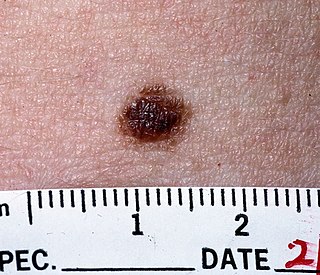
Nevus is a nonspecific medical term for a visible, circumscribed, chronic lesion of the skin or mucosa. The term originates from nævus, which is Latin for "birthmark"; however, a nevus can be either congenital or acquired. Common terms, including mole, birthmark, and beauty mark, are used to describe nevi, but these terms do not distinguish specific types of nevi from one another.

Nail polish is a lacquer that can be applied to the human fingernail or toenails to decorate and protect the nail plates. The formula has been revised repeatedly to enhance its decorative effects and to suppress cracking or peeling. Nail polish consists of a mix of an organic polymer and several other components that give it colors and textures. Nail polishes come in all shades of color and play a significant part in manicures or pedicures.
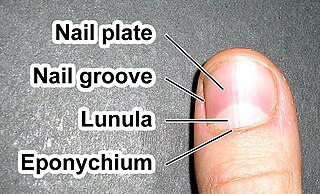
The lunula, or lunulae (pl.), is the crescent-shaped whitish area of the bed of a fingernail or toenail.
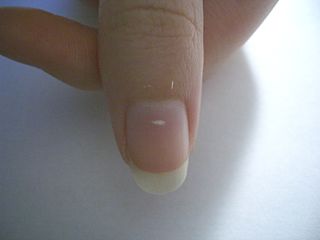
Leukonychia, is a medical term for white discolouration appearing on nails. It is derived from the Greek words leuko 'white' and onyx 'nail'. The most common cause is injury to the base of the nail where the nail is formed.
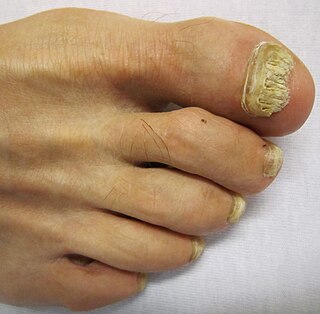
Onychomycosis, also known as tinea unguium, is a fungal infection of the nail. Symptoms may include white or yellow nail discoloration, thickening of the nail, and separation of the nail from the nail bed. Toenails or fingernails may be affected, but it is more common for toenails. Complications may include cellulitis of the lower leg. A number of different types of fungus can cause onychomycosis, including dermatophytes and Fusarium. Risk factors include athlete's foot, other nail diseases, exposure to someone with the condition, peripheral vascular disease, and poor immune function. The diagnosis is generally suspected based on the appearance and confirmed by laboratory testing.
Chrysiasis is a dermatological condition induced by the parenteral administration of gold salts, usually for the treatment of rheumatoid arthritis. Such treatment has been superseded as the best practice for treating the disease because of "numerous side effects and monitoring requirements, their limited efficacy, and very slow onset of action".
Carotenosis is a benign and reversible medical condition where an excess of dietary carotenoids results in orange discoloration of the outermost skin layer. The discoloration is most easily observed in light-skinned people and may be mistaken for jaundice. Carotenoids are lipid-soluble compounds that include alpha- and beta-carotene, beta-cryptoxanthin, lycopene, lutein, and zeaxanthin. The primary serum carotenoids are beta-carotene, lycopene, and lutein. Serum levels of carotenoids vary between region, ethnicity, and sex in the healthy population. All are absorbed by passive diffusion from the gastrointestinal tract and are then partially metabolized in the intestinal mucosa and liver to vitamin A. From there they are transported in the plasma into the peripheral tissues. Carotenoids are eliminated via sweat, sebum, urine, and gastrointestinal secretions. Carotenoids contribute to normal-appearing human skin color, and are a significant component of physiologic ultraviolet photoprotection.
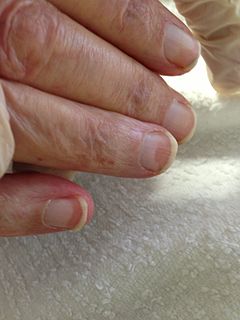
Terry's nails is a physical condition in which a person's fingernails or toenails appear white with a characteristic "ground glass" appearance without any lunula. The condition is thought to be due to a decrease in vascularity and an increase in connective tissue within the nail bed. It frequently occurs in the setting of liver failure, cirrhosis, diabetes mellitus, congestive heart failure, hyperthyroidism, or malnutrition. Eighty percent of patients with severe liver disease have Terry's nails, but they are also found in people with kidney failure, in patients with congestive heart failure and are described as a brown arc near the ends of the nails. The recognition of characteristic nail patterns, such as Terry's nails, may be a helpful herald for early diagnosis of systemic diseases. This finding was named for Richard Terry.
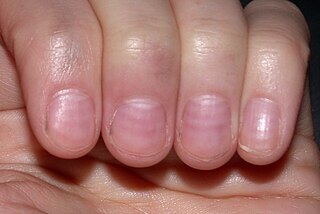
Muehrcke's nails or Muehrcke's lines are changes in the fingernail that may be a sign of an underlying medical condition. The term refers to a set of one or more pale transverse bands extending all the way across the nail, parallel to the lunula. In contrast to Beau's lines, they are not grooved, and in contrast to Mees' lines, the thumb is usually not involved.
Metal toxicity or metal poisoning is the toxic effect of certain metals in certain forms and doses on life. Some metals are toxic when they form poisonous soluble compounds. Certain metals have no biological role, i.e. are not essential minerals, or are toxic when in a certain form. In the case of lead, any measurable amount may have negative health effects. Often heavy metals are thought as synonymous, but lighter metals may also be toxic in certain circumstances, such as beryllium and lithium. Not all heavy metals are particularly toxic, and some are essential, such as iron. The definition may also include trace elements when in abnormally high doses may be toxic. An option for treatment of metal poisoning may be chelation therapy, which is a technique which involves the administration of chelation agents to remove metals from the body.
Half and half nails show the proximal portion of the nail white and the distal half red, pink, or brown, with a sharp line of demarcation between the two halves. Seventy percent of hemodialysis patients and 56% of renal transplant patients have at least one type of nail abnormality. Absence of lunula, splinter hemorrhage, and half and half nails were significantly more common in hemodialysis patients, while leukonychia was significantly more common in transplant patients.
Congenital onychodysplasia of the index fingers is defined by the presence of the condition at birth, either unilateral or bilateral index finger involvement, variable distortion of the nail or lunula, and polyonychia, micronychia, anonychia, hemionychogryphosis, or malalignment.
Spotted lunulae is a distinctive change that occurs with alopecia areata.
Median nail dystrophy consists of longitudinal splitting or canal formation in the midline of the nail, a split which often resembles a fir tree, occurring at the cuticle and proceeding outward as the nail grows.
References
- ↑ James, William; Berger, Timothy; Elston, Dirk (2005). Andrews' Diseases of the Skin: Clinical Dermatology. (10th ed.). Saunders. ISBN 0-7216-2921-0.
- ↑ Tosti, Antonella; Iorizzo, Matilde; Piraccini, Bianca Maria; Starace, Michela (July 2006). "The Nail in Systemic Diseases". Dermatologic Clinics. 24 (3): 341–347. doi:10.1016/j.det.2006.03.005. PMID 16798431.